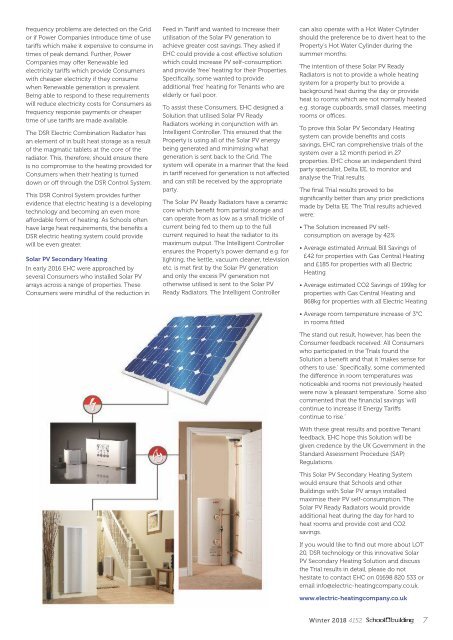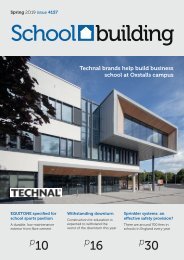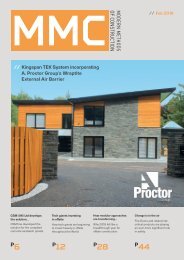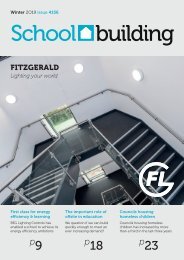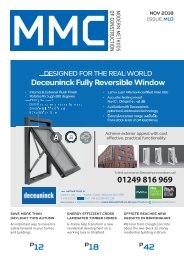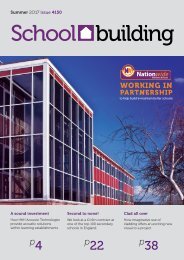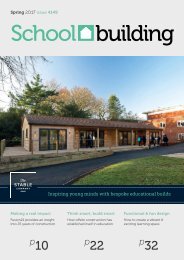You also want an ePaper? Increase the reach of your titles
YUMPU automatically turns print PDFs into web optimized ePapers that Google loves.
frequency problems are detected on the Grid<br />
or if Power Companies introduce time of use<br />
tariffs which make it expensive to consume in<br />
times of peak demand. Further, Power<br />
Companies may offer Renewable led<br />
electricity tariffs which provide Consumers<br />
with cheaper electricity if they consume<br />
when Renewable generation is prevalent.<br />
Being able to respond to these requirements<br />
will reduce electricity costs for Consumers as<br />
frequency response payments or cheaper<br />
time of use tariffs are made available.<br />
The DSR Electric Combination Radiator has<br />
an element of in built heat storage as a result<br />
of the magmatic tablets at the core of the<br />
radiator. This, therefore, should ensure there<br />
is no compromise to the heating provided for<br />
Consumers when their heating is turned<br />
down or off through the DSR Control System.<br />
This DSR Control System provides further<br />
evidence that electric heating is a developing<br />
technology and becoming an even more<br />
affordable form of heating. As Schools often<br />
have large heat requirements, the benefits a<br />
DSR electric heating system could provide<br />
will be even greater.<br />
Solar PV Secondary Heating<br />
In early 2016 EHC were approached by<br />
several Consumers who installed Solar PV<br />
arrays across a range of properties. These<br />
Consumers were mindful of the reduction in<br />
Feed in Tariff and wanted to increase their<br />
utilisation of the Solar PV generation to<br />
achieve greater cost savings. They asked if<br />
EHC could provide a cost effective solution<br />
which could increase PV self-consumption<br />
and provide ‘free’ heating for their Properties.<br />
Specifically, some wanted to provide<br />
additional ‘free’ heating for Tenants who are<br />
elderly or fuel poor.<br />
To assist these Consumers, EHC designed a<br />
Solution that utilised Solar PV Ready<br />
Radiators working in conjunction with an<br />
Intelligent Controller. This ensured that the<br />
Property is using all of the Solar PV energy<br />
being generated and minimising what<br />
generation is sent back to the Grid. The<br />
system will operate in a manner that the feed<br />
in tariff received for generation is not affected<br />
and can still be received by the appropriate<br />
party.<br />
The Solar PV Ready Radiators have a ceramic<br />
core which benefit from partial storage and<br />
can operate from as low as a small trickle of<br />
current being fed to them up to the full<br />
current required to heat the radiator to its<br />
maximum output. The Intelligent Controller<br />
ensures the Property’s power demand e.g. for<br />
lighting, the kettle, vacuum cleaner, television<br />
etc. is met first by the Solar PV generation<br />
and only the excess PV generation not<br />
otherwise utilised is sent to the Solar PV<br />
Ready Radiators. The Intelligent Controller<br />
can also operate with a Hot Water Cylinder<br />
should the preference be to divert heat to the<br />
Property’s Hot Water Cylinder during the<br />
summer months.<br />
The intention of these Solar PV Ready<br />
Radiators is not to provide a whole heating<br />
system for a property but to provide a<br />
background heat during the day or provide<br />
heat to rooms which are not normally heated<br />
e.g. storage cupboards, small classes, meeting<br />
rooms or offices.<br />
To prove this Solar PV Secondary Heating<br />
system can provide benefits and costs<br />
savings, EHC ran comprehensive trials of the<br />
system over a 12 month period in 27<br />
properties. EHC chose an independent third<br />
party specialist, Delta EE, to monitor and<br />
analyse the Trial results.<br />
The final Trial results proved to be<br />
significantly better than any prior predictions<br />
made by Delta EE. The Trial results achieved<br />
were:<br />
• The Solution increased PV selfconsumption<br />
on average by 42%<br />
• Average estimated Annual Bill Savings of<br />
£42 for properties with Gas Central Heating<br />
and £185 for properties with all Electric<br />
Heating<br />
• Average estimated CO2 Savings of 199kg for<br />
properties with Gas Central Heating and<br />
868kg for properties with all Electric Heating<br />
• Average room temperature increase of 3°C<br />
in rooms fitted<br />
The stand out result, however, has been the<br />
Consumer feedback received. All Consumers<br />
who participated in the Trials found the<br />
Solution a benefit and that it ‘makes sense for<br />
others to use.’ Specifically, some commented<br />
the difference in room temperatures was<br />
noticeable and rooms not previously heated<br />
were now ‘a pleasant temperature.’ Some also<br />
commented that the financial savings ‘will<br />
continue to increase if Energy Tariffs<br />
continue to rise.’<br />
With these great results and positive Tenant<br />
feedback, EHC hope this Solution will be<br />
given credence by the UK Government in the<br />
Standard Assessment Procedure (SAP)<br />
Regulations.<br />
This Solar PV Secondary Heating System<br />
would ensure that Schools and other<br />
Buildings with Solar PV arrays installed<br />
maximise their PV self-consumption. The<br />
Solar PV Ready Radiators would provide<br />
additional heat during the day for hard to<br />
heat rooms and provide cost and CO2<br />
savings.<br />
If you would like to find out more about LOT<br />
20, DSR technology or this innovative Solar<br />
PV Secondary Heating Solution and discuss<br />
the Trial results in detail, please do not<br />
hesitate to contact EHC on 01698 820 533 or<br />
email info@electric-heatingcompany.co.uk.<br />
www.electric-heatingcompany.co.uk<br />
Winter 2018 <strong>4152</strong> 7


